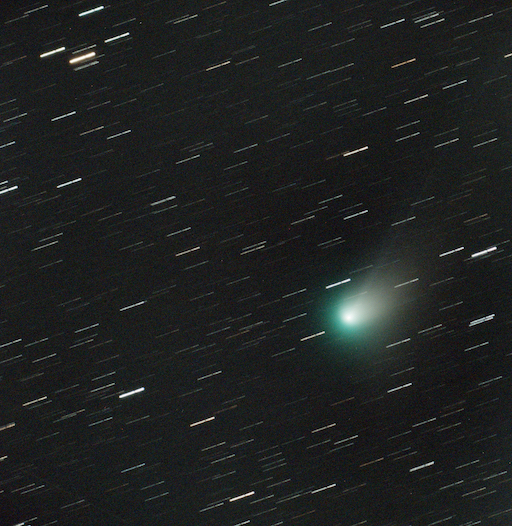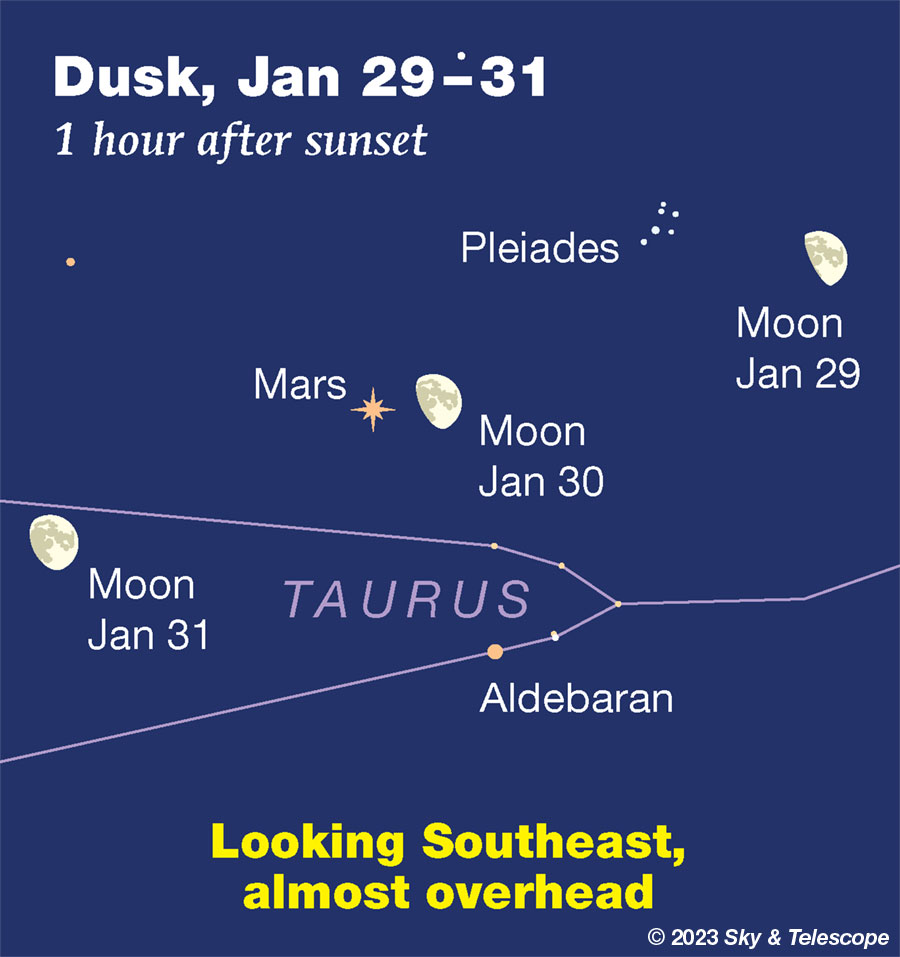Comet ZTF is at its best, but here comes the Moon. Comet C/2022 E3 (ZTF) has been brightening ever since the automated Zwicky Transient Facility discovered it at 17th magnitude last March. Now it's finally attaining its peak predicted brightness, while passing the Little Dipper in the northern sky. As of January 27th was about magnitude 5.2, on its way to probably 5.0 at the very end of January and the beginning of February. But moonlight is returning, so don't wait!
 Comet ZTF E3 imaged on January 16th by Alain Jouchoux of Boulder, Colorado. This is a stack of 30 two-minute exposures that he took with an 80-mm EDF refractor from his front porch using "my new ZWO detector."In dark skies people who know exactly where to look are even seeing this little comet naked-eye. Even through a fairly light-polluted sky it's in reach of binoculars — if you have a chart that pinpoints the changing location to examine each night, and if you can find the mostly dim Little Dipper. (Hint: The end of its long handle is Polaris, the North Star, due north.) Comet ZTF E3 imaged on January 16th by Alain Jouchoux of Boulder, Colorado. This is a stack of 30 two-minute exposures that he took with an 80-mm EDF refractor from his front porch using "my new ZWO detector."In dark skies people who know exactly where to look are even seeing this little comet naked-eye. Even through a fairly light-polluted sky it's in reach of binoculars — if you have a chart that pinpoints the changing location to examine each night, and if you can find the mostly dim Little Dipper. (Hint: The end of its long handle is Polaris, the North Star, due north.)
See Bob King's article Circumpolar Comet ZTF (C/2022 E3) is Here! It has the finder chart you need. On the chart, the dates on the comet's track are for oh Universal Time, which in North America falls on the evening of the previous date.
Late on the night of January 27-28 the comet was pretty easy in my 10x50 binoculars even through suburban light pollution (the Moon had set). It appeared as a mostly shapeless, diffuse little fuzzy patch among the stars, with little or no concentration toward its middle. Averted vision helped a lot. Not sure if the hint of green was my imagination. No trace of it to the naked eye in this typical sky. Remember, cameras these days are far better than the human eye, especially in the hands of astrophotographers who how to use them well, such as by stacking many exposures (see the February Sky & Telescope, page 55). I wish more of the news media knew to say this.
As of Saturday night January 28-29, Gamma and brighter Beta Ursae Majoris, the end stars of the Little Dipper's bowl, point (in that order) toward the comet. It'll be dimly glowing a little more than twice the distance between the two stars, not quite along the same line. The waxing Moon sets around midnight.
Comet ZTF passes Polaris on the nights of Jan. 29-30 and 30-31. But by then moonlight will pose growing interference, with the Moon brightening and setting roughly an hour later each night.
Bright moonlight will flood the sky from dusk to dawn from February 2nd or 3rd through the 6th. Then a good moonless window will begin opening in the early evening around February 7th, with the comet now fading as it crosses Auriga.
FRIDAY, JANUARY 27
¦ Orion is high in the southeast right after dark, and he stands highest due south around 9 p.m. Orion is the brightest of the 88 constellations, but his main pattern is surprisingly small compared to some of his dimmer neighbors. The biggest of these is Eridanus the River to his west, enormous but hard to trace. Dimmer Fornax the Furnace, to Eridanus's lower right, is almost as big as Orion! Even the main pattern of Lepus, the Hare cowering under the Hunter's feet, isn't much smaller than he is.
Do you know the constellation down below Lepus? It's a tough one: Columba the Dove, faint, sprawly, and to my eye not a bit dove-like. See the constellation chart in the center of the February Sky & Telescope. Its brightest star, Alpha Columbae or Phact, is magnitude 2.6. To find it, draw a line from Rigel through Beta Leporis (the front of the bunny's neck) and extend it an equal distance straight on.
SATURDAY, JANUARY 28
¦ First-quarter Moon (exactly so at 10:19 a.m. EST). The Moon is partway between Mars to its left and Jupiter farther to its lower right. During twilight, Venus and dim Saturn complete the lineup low in the west-southwest. A line from the Moon through Jupiter points to them —because the Moon and planets all lie nearly on the great circle of the ecliptic. Uranus and Neptune are also part of this evening lineup, though out of naked-eye sight.
SUNDAY, JANUARY 29
¦ The waxing gibbous Moon shines west of the Pleiades, Mars, and Aldebaran, as shown below.
 The Moon crosses Taurus at month's end. On the night of the 30th, if you're in the Americas you can watch the Moon either occult Mars or miss it, depending on where you are. See below. (The Moon here is always drawn three times its actual apparent size.)MONDAY, JANUARY 30 The Moon crosses Taurus at month's end. On the night of the 30th, if you're in the Americas you can watch the Moon either occult Mars or miss it, depending on where you are. See below. (The Moon here is always drawn three times its actual apparent size.)MONDAY, JANUARY 30
Moon occults Mars. Tonight the Moon's dark limb will occult (cover) Mars for observers south of a line running from south Georgia across the U.S. through central California. Here's a Google map of the line, showing the width of the partial-occultation zone along it, courtesy of Derek Breit and David Dunham of the International Occultation Timing Association. Zoom in.
The occultation's southern limit crosses northwestern South America. Skywatchers elsewhere in North and South America will see the Moon perform a near miss of Mars.
Here are IOTA's timetables. The first two tables are very long; the first gives the time for Mars's disappearance, the second for its reappearance from behind the Moon's bright limb. Scroll to be sure you're using the right table; watch for the new heading as you scroll. The first two letters in each entry are the country abbreviation ("CA" is Canada, not California). The times are given in UT (GMT), which is 5 hours ahead of Eastern Standard Time, 6 ahead of CST, 7 ahead of MST, and 8 ahead of PST.
For instance: At Los Angeles, Mars disappears at 8:35 p.m. PST tonight when the Moon is 76° above the horizon, then reappears at 9:29 p.m. PST when the Moon is 65° high.
TUESDAY, JANUARY 31
¦ Tonight Comet ZTF E3 is practically at its closest to Earth and is at its predicted peak brightness. But you have only about a one-hour window of dark sky left now between moonset and the beginning of Wednesday's dawn! Set your alarm to go outside, preferably with binoculars or telescope, about 2½ hours before your sunrise time. By that hour the comet, now in Camelopardalis, will be high in the north-northwest, about 17° lower left of Polaris. See the top of this page and the chart in Circumpolar Comet ZTF (C/2022 E3) is Here!
WEDNESDAY, FEBRUARY 1
¦ Right after dark, face east and look very high, almost overhead. The bright star there is Capella, the Goat Star. To the right of it, by a couple of finger-widths at arm's length, is a small, narrow triangle of 3rd and 4th magnitude stars known as "The Kids." Though they're not exactly eye-grabbing, they form a never-forgotten asterism with Capella. Binoculars reveal it well through the moonlight.
THURSDAY, FEBRUARY 2
¦ The waxing gibbous Moon shines in the heart of Gemini, forming a nearly isosceles triangle with Castor and Pollux to its left in the evening.
¦ Spot the big, bright, equilateral Winter Triangle in the southeast, lower left of the Moon. Sirius is its brightest and lowest star. Betelgeuse stands above Sirius by about two fists at arm's length. To their left shines Procyon.
Can you discern their colors? Sirius (spectral type A0) is cold white, Betelgeuse (M2) is yellow-orange, and Procyon (F5) is white with just a slight touch of yellow.
And, standing 4° above Procyon is 3rd-magnitude Gomeisa, or Beta Canis Minoris, the only other easy naked-eye star of Canis Minor. (It'll be easier next week when the Moon is gone.)
FRIDAY, FEBRUARY 3
¦ Now the nearly full Moon shines just below Pollux and Castor during evening. It forms a straight line with them when the stars come out over the eastern Canadian Maritimes. The line they make is slightly curved by the time of dusk for the rest of the continent.
SATURDAY, FEBRUARY 4
¦ The Moon is well below Castor and Pollux in early evening. It makes a very broad, gentle arc with Procyon to its right and Sirius about equally far to the right or lower right of Procyon.
SUNDAY, FEBRUARY 5
¦ Full Moon (exactly full at 1:29 p.m. EST). The Moon, in Leo, rises in the east-northeast within a few minutes of sunset. Once the Moon is well up after dark, you can see it forming an isosceles triangle once again with Regulus and Algieba, the two brightest stars of Leo's Sickle. |





 Comet ZTF E3 imaged on January 16th by Alain Jouchoux of Boulder, Colorado. This is a stack of 30 two-minute exposures that he took with an 80-mm EDF refractor from his front porch using "my new ZWO detector."In dark skies people who know exactly where to look are even seeing this little comet naked-eye. Even through a fairly light-polluted sky it's in reach of binoculars — if you have a chart that pinpoints the changing location to examine each night, and if you can find the mostly dim Little Dipper. (Hint: The end of its long handle is Polaris, the North Star, due north.)
Comet ZTF E3 imaged on January 16th by Alain Jouchoux of Boulder, Colorado. This is a stack of 30 two-minute exposures that he took with an 80-mm EDF refractor from his front porch using "my new ZWO detector."In dark skies people who know exactly where to look are even seeing this little comet naked-eye. Even through a fairly light-polluted sky it's in reach of binoculars — if you have a chart that pinpoints the changing location to examine each night, and if you can find the mostly dim Little Dipper. (Hint: The end of its long handle is Polaris, the North Star, due north.) The Moon crosses Taurus at month's end. On the night of the 30th, if you're in the Americas you can watch the Moon either occult Mars or miss it, depending on where you are. See below. (The Moon here is always drawn three times its actual apparent size.)MONDAY, JANUARY 30
The Moon crosses Taurus at month's end. On the night of the 30th, if you're in the Americas you can watch the Moon either occult Mars or miss it, depending on where you are. See below. (The Moon here is always drawn three times its actual apparent size.)MONDAY, JANUARY 30